
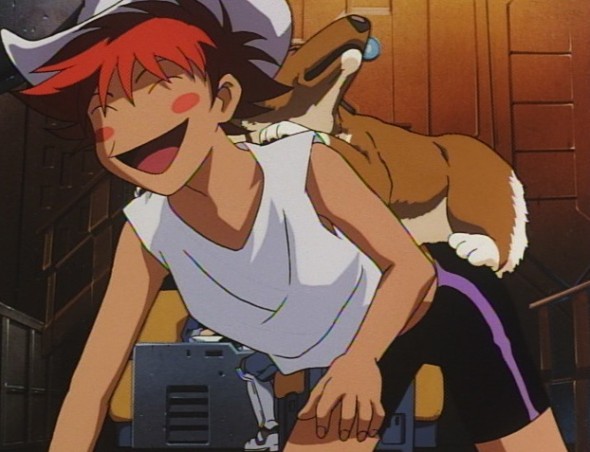
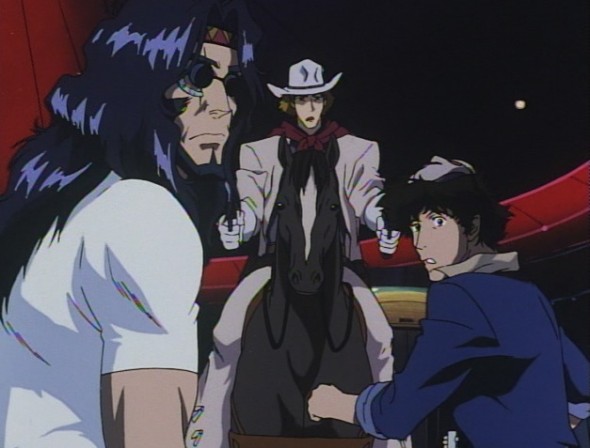
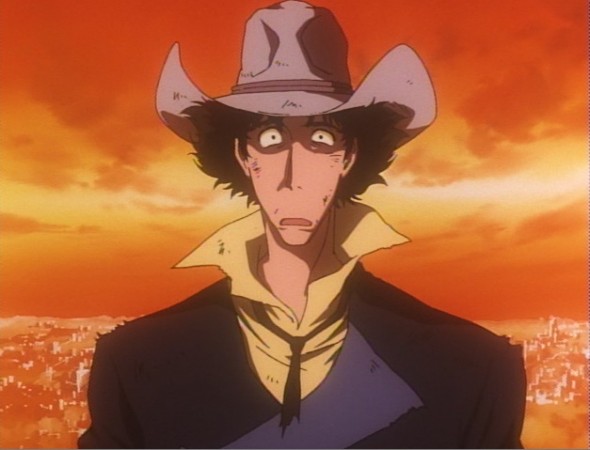
22) Cowboy Funk
Well, it happened. I suppose you couldn’t have a show that’s about stylistic pastiche and called “Cowboy Bebop” without throwing in an actual cowboy at some point. This is a flatly hilarious episode – the last of these, I think that we’ll get for the duration of the series. It begins with Spike tracking down a terrorist named “The Teddy Bomber,” who likes to blow up skyscrapers with explosive teddy bears. This guy is one of the more interesting villains that the series has come up with so far, and seems like a perfectly valid conceit to base an episode around when suddenly –
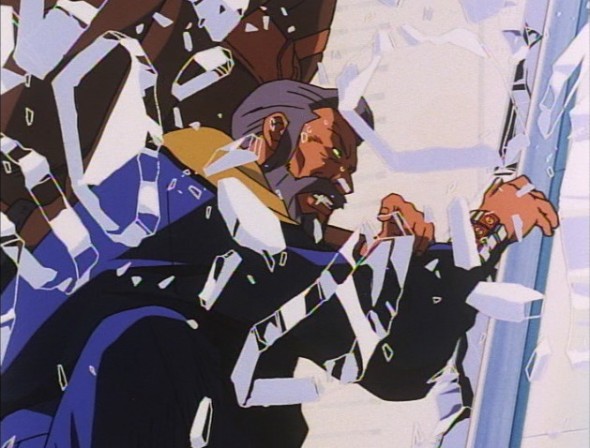
- HOOOOOOOOORSE!
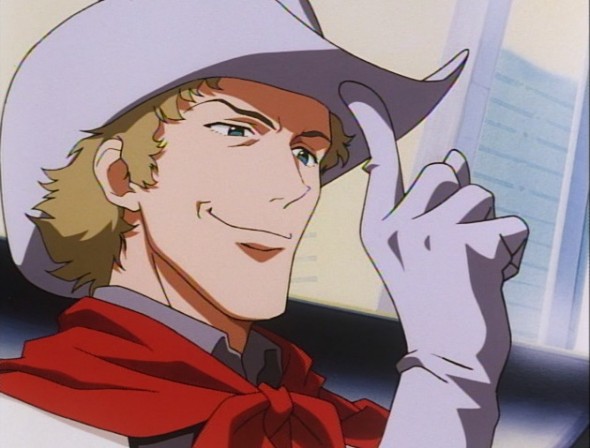
So let me explain. During his confrontation with Spike, Teddy lets slip that there are only two bounty hunters that he’s honestly afraid of: Spike, and Andy. Spike is pleased as punch to hear that he has a reputation (possibly the most honestly pleased we ever see him get, about anything, over the entire run), but perplexed that he’s never heard of this Andy guy… and then Andy comes sailing through the window. Andy, it turns out, is a cowboy. Not in the sense that it’s usually used on this show, where it just means “bounty hunter,” but an actual cowboy – or at least a cowboy LARPer. He used to be part of the YMCA (that’s “Young Men’s Cowboy Asociation” – no joke), but got kicked out for being too ornery. Although it never comes up in the show, I think there’s at least a possibility that the only reason he takes in bounties in the first place is that people use the term “cowboy” to refer to that career. In case it wasn’t obvious already, Andy is dangerously insane, and not a little dumb. For instance, right after charging through the window, he tries to arrest Spike as the Teddy Bomber, and while they’re yelling at each other, the real bomber blows up the building and gets away.
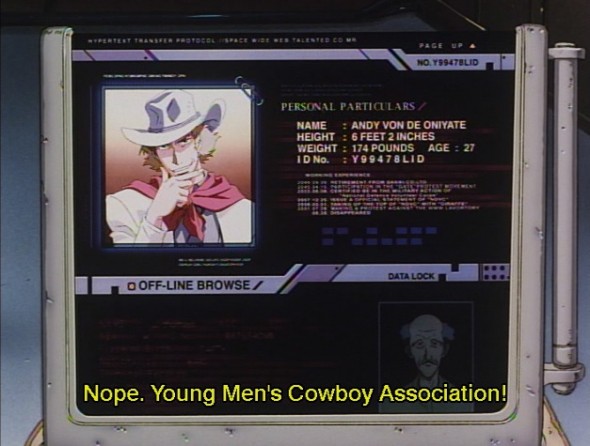
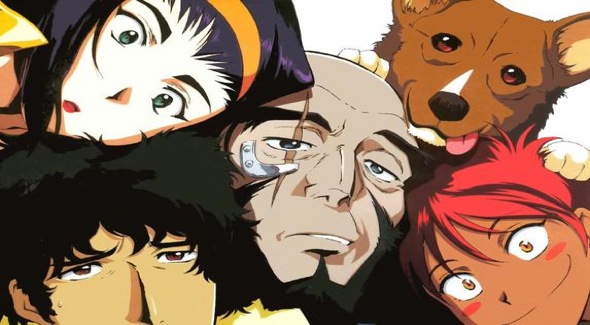
“By the way, this awesome orange color scheme is used nowhere else in the episode. In fact, the rest of it is pretty much blue, making it the extended version of that one obnoxious high-contrast color scheme they use in every single movie poster nowadays. Bebop did it before it was lame, though.”
I hope everyone is aware of this phenomenon. It’s quite striking. For an extensive gallery of examples:
http://www.slashfilm.com/2009/11/27/orangeblue-contrast-in-movie-posters/
Ah, I knew there was a gallery somewhere! I wanted to link to it but I couldn’t remember what website it was on. Thanks for that, Lee.
Although I’d call the trend more “damning” than “striking.” :-/
I can’t add anything here but I thought I would take out space and say that these articles are awesome.
Agreed. I love these articles and am really happy whenever a new one comes out.
8 pages?? F-yeah!
It’ll be a sad day when these are finished up and the series has been overthought. :D I hope you plan on doing the movie once the series is done!
One question I have about Spike’s “massive death wish.” It could be that, but I always figured Spike as a young guy to be an adrenaline junkie. He gets his thrills from dangerous situations. Unless that’s the same as a death wish. :D
I’ll probably do something about the movie… not sure quite what, though. I’ve been thinking a lot about how one could make Cowboy Bebop into a movie (because of the threatened live-action, all-Keanu-all-the-time remake), and I’m interested in how the show’s own creative team handled it. So one thought I had was to end my posts on the show itself with a list of dos and don’ts for a cinematic adaptation, and then watch the movie and see how it stacks up against that.
As for Spike’s death wish: I think at the beginning of the series, he comes off a lot more like an adrenaline junky (especially in the first episode, where he’s not interested in fighting Solensan until he realizes that the guy is nigh-indestructible), but that as the show goes on it seems more and more like he’s actually interested in finding his death, for a bunch of quasi-existential reasons. Before he goes off to fight Pierrot he actually says something like “Maybe this will finally be the one…” doesn’t he? He tries to play it off as a joke immediately afterwards, of course, but I don’t think we’re meant to believe him. I’ll go into this more in a future post, though. You bring up an interesting question.
MASSIVE SPOILER
*
*
*
*
*
*
*
*
*
*
The entire series is about death because, as we find out in the final series of episodes, Spike’s soul has basically been dead for years, and all that is left is for him to redeem his disgraceful life and die a Samurai’s death. Which of course he does.
Although, he’s marekd for death.
But, for real, the entire series is about redemption by chosing to die a good death.
In terms of Andy’s “death of cowboy identity”, what do you make of the end title reading “See You Space Samurai”? This might make the whole thing less a death than a transformation–Andy is still just as crazy, hokey and pseudo-cool as ever, he’s just swapped the superficial stereotype he’s imitating. (And even then, the cowboy stereotype arguably has a lot in common with the samurai one; you could argue that they’re similar archetypes.)
Anyway, awesome article!
I’ll see your “less a death than a transformation” and raise you a “what is death but a transformation?” When he hands Spike the hat and walks away, you’re supposed to think that his cowboy persona is dead (go ahead and put scare quotes around that if you want to). When he shows up as the samurai at the end, I find that it reads as a resurrection, or maybe a life-after-death, which amounts to pretty much the same thing.
The similarity of the cowboy and samurai archetypes is interesting, in that actual cowboys and actual samurai are about as different from each other as two groups of people have ever been. But in pop culture, they do seem to be functionally equivalent.